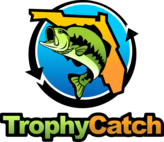
The big news as last quarter ended was the awarding of the Season 8 Phoenix bass boat to Vance Mccullers from Lutz. Boat partners Mercury Marine and Lowrance were at the TrophyCatch boat drawing to conduct the “reverse drawing,” meaning the last name drawn out of the bucket was the winner of the TrophyCatch boat package.
“Four of the finalists submitted multiple fish to TrophyCatch while one angler simply registered for the program and had one entry into the boat drawing,” said Tom Graef, Director of the Division of Freshwater Fisheries. “As finalists all had an equal chance to be a brand-new Phoenix boat owner and no fish submission was required to be eligible. Anyone registered in TrophyCatch has the chance to win big!”
|
The five Season 8 Phoenix Boat finalists were all present for the reverse drawing. All that's required to be standing here next year is registering for TrophyCatch!
 “Thank you to TrophyCatch. I appreciate this so much,” said lucky Season 8 boat winner Vance Mccullers. “I told my wife if I come home with this boat, I’m going to believe her golden horseshoe story. Now I’m going to come home with it attached to my truck!”
The Phoenix Boat Package is a brand-new Phoenix 819 powered by Mercury Pro XS 200, guided by Lowrance electronics and Ghost trolling motor and anchored by Power-Pole. Partner WrapThis also helped draw attention to the boat while being towed by the Ford F-150 TrophyCatch truck provided by Bartow Ford. The video of the final drawing can be viewed here. TrophyCatch Season 9 is now well underway with an impressive roster of catches already submitted, and more to come! See TrophyCatch.com for participation details and to register, and follow us on Facebook.
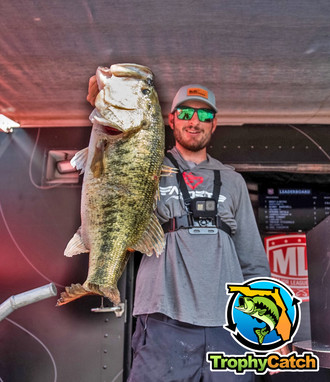 |
The biggest prize of the Apopka Fish Challenge has been caught! The FWC and partner Friends of Lake Apopka (FOLA) congratulate Christian Greico from Tampa on catching the $5,000 prize Jim Thomas trophy bass during the Lake Apopka Fish Challenge, which began in January and ends May 31, 2021. FWC biologists tagged the twelve-pound largemouth bass called “Jim Thomas” after the Winter Garden environmentalist who founded FOLA before the fish challenge began. Check out Greico's video of the actual landing of "Jim Thomas" at this link! There are still tagged bass, bream and specks representing about $5,000 more in prizing swimming the lake, so don't stop fishing!
 "Jim Thomas" is a bass bearing a $2,500 tag which was also successfully submitted and approved to TrophyCatch for an additional $2,500!
Grass carp are a conditional species in Florida (68-5.002, Florida Administrative Code) and can only be possessed by permit. Any grass carp caught must be released immediately.
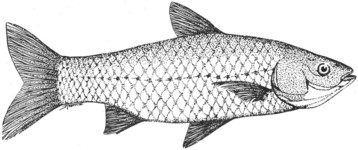
Size: The largest triploid grass carp documented in Florida was 15 years old, 56" long and weighed 75 lbs. Because this is a conditional species in Florida it is not eligible for State Records or Big Catch.
Identification and similar species: The grass carp is one of the largest members of the minnow family. The back of the grass carp is silvery to dark grey, and the sides of the body are lighter with a slightly golden sheen. The belly is silvery white. Fins are generally greenish grey. The fish has relatively large scales. The body shape is oblong with a round belly and broad head. Teeth have been replaced by specialized structures called pharyngeal teeth (see photo) located in the back of the throat. These are used for tearing and grinding plant matter.
By contrast, common carp have a laterally compressed, robust body (deep bodied from the back of the fish to the belly) and are easily distinguished by the presence of barbels (whiskers) located at the corners of the mouth.
Angling qualities: Sometimes taken by anglers, especially those fishing for catfish or tilapia, but they must be released immediately and unharmed since those found in Florida were stocked deliberately for aquatic plant control purposes. As the name implies grass carp consume higher aquatic plants and submerged grasses (rooted macrophytes as opposed to algaes); they will also eat detritus, insects and other invertebrates when necessary. Because of their feeding behavior, they are used in this country under special restricted circumstances (see the FWC Grass Carp Permit page for details) to help manage aquatic plant problems. Many aquatic plants that pose problems in Florida are exotic and have few natural insect or disease controls, consequently they frequently create problems with access, navigation, flood control, irrigation and aesthetics. Since chemical herbicides and mechanical removal are costly alternatives, biocontrol agents, such as triploid grass carp can provide a beneficial tool. Triploid grass carp have three sets of chromosomes, instead of the normal two, which renders them functionally sterile. Triploids are produced artificially, by using hormones, stripping the eggs and mixing them with milt, then subjecting the fertilized egg to hydrostatic pressure, and finally suspending the fertilized eggs in well-aerated containers until they hatch. The resultant fish must be individually tested using a Coulter Counter, in a certification process developed by FWC biologists prior to being permitted for use. The FWC helps protect aquatic habitats by restricting the use of grass carp via permits to only these sterile fish and limiting the number allowed.
Where to find them: The grass carp is native to large coastal rivers in Siberia and China. In Florida, sterile Triploid Grass Carp are stocked throughout the state by permit for biological vegetation control.
|
Almost anyone who fishes will tell you that this is an equipment-oriented sport. In many ways, the quality of your tackle and the care you take with it will determine your success on the water. Fortunately, most fishing equipment is relatively maintenance-free. Other gear usually only requires a small time investment to keep it going. A few minutes of maintenance here and there, along with a bit of extra care once you leave the house, can mean years added to the life of your fishing equipment.

Reels – We’ll start with the highest-maintenance piece of equipment first. If you do it right, you’ll probably spend more time taking care of your reels than you will all the rest of your fishing gear combined. However, don’t despair—that still doesn’t mean a big time investment. Spinning and spincast reels are relatively easy for most anglers to service themselves. In most cases, simply removing the handle and main cover plate over the reel gears and squirting some reel grease onto all the moving parts is the only annual maintenance required. Wipe out as much old grease as you can reach first, though, and make sure you’re using reel grease and not reel oil on the main gears, as the grease will remain in place much longer. If dirt or sand has worked its way into the gearcase, you will need to remove all dirty gears and clean them individually, as well as the gear housing, before reassembling and greasing the affected parts. This is a good reason to save the parts diagram that comes with each new reel. Most spinners are relatively simple in assembly, but do pay special attention to bushings or any other parts that will need to go back into the reel a specific way that’s not readily apparent just from eyeballing the parts diagram or the part itself.
|

Another excellent reason to save parts diagrams is for ordering spare or replacement parts. You should obtain a couple extra bail springs for each spinning reel you own. Keep the spare bail springs, along with a pocket tool kit, in your tackle box, especially if you’re going on a trip. Being able to perform a bail spring replacement in the field can save a fishing excursion! Bail springs are often slightly longer at one end than the other, so pay special attention to where the “long” end of the spring goes when you initially remove the bail spring cover to perform a replacement. These springs also tend to pop out during installation, so if you have a choice, work over pavement rather than grass.
On the other hand, baitcasting reels—with centrifugal casting controls and other intricate workings—are far more complex than spinners. Lubrication and maintenance beyond that recommended by the owner’s manual is usually best left to the local designated service center. Manufacturer-approved service centers are usually listed in either the owner’s manual or in a separate flyer included with the reel.
|
 Rods – Modern rods are pretty much maintenance-free. Dirty handles, whether cork or foam, can usually be cleaned with water and a rag; you can use a small amount of mild soap if necessary. Occasionally check that none of the ceramic rod guides are cracked. On older rods with chrome guides, make sure the line has not worn a groove into the guides, especially the tiptop. Note that these old chrome guides will be grooved by modern braids; if you've just switched to braided line, you may need to replace your oldest rods. You can check any rod guide by wiping it with a Q-tip and looking for fibers caught on any cracks or imperfections. A rod tip repair kit squirreled away in the bottom of your tackle box can be a real trip-saver. Fiberglass rods are very durable, but graphite rods require more care. Avoid striking a graphite rod against any sharp corner or edge, as damage to the rod blank can cause it to break when flexed. Also watch out for any and all doors, whether in homes or vehicles! Never twist the assembled sections of a two-piece rod to line up the guides; instead, visually line up the guides beforehand and then slide the ferrules together. If the guides are misaligned, pull the rod sections straight apart and try again—don’t twist the two sections! Keep both ends of the rod ferrules clean of sand or dirt. On older rods, you may need to wax the metal ferrules to keep them from corroding (permanently!) together. Waxing will also help on any two-piece rod if the tip section has a tendency to rattle or come loose during casting.
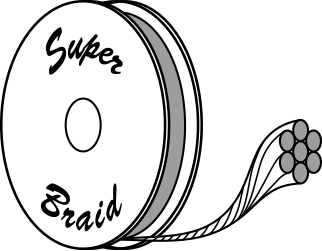
Fishing Line – Another low-maintenance item, line will last quite a while if it’s kept in a relatively cool place and out of direct sunlight. If you keep your rods in the bedroom or the hall closet, you will probably only need to change line when it gets low on the spool. In such cases, you can usually get away with pulling off old line until you’re about halfway down on the spool, then attaching the new line with a blood knot and refilling the spool from the halfway point. However, all the line on rods stored in your pickup’s window rack, car trunk, or garage should be changed on an annual basis, especially if it's monofilament. Obviously, bulk line spools should be kept indoors and cool if you expect the line to remain good until the spool is empty. When fishing, occasionally feel the line as it is winding onto the reel for any abrasions and replace as needed.
|

Tackle Boxes – A traditional hard tackle box simply needs to be wiped down occasionally, or emptied or vacuumed to remove leaf litter, line scraps, or other debris that tends to collect in the bottom. Sometimes the rivets holding a tackle box handle in place will fall out, in which case appropriately sized bolts will repair it. For added strength, use a fender washer on the inside of the tackle box when you bolt the handle back in place to distribute carrying stresses over a wider area of the lid. This also helps if the rivet tore through the plastic of the lid, rather than just broke. If you open your tackle box while fishing in the rain, simply leaving it open overnight upon returning home will usually be enough to let it dry out, especially if your lure trays are ribbed. Leave the lure trays extended as well for maximum air circulation when drying out the box. If necessary, use paper towels to dry off the interior as much as you can before leaving it open to finish drying. (NOTE: If pets or children are present, be sure to place the box out of reach.) Remember to open any mini tackle boxes stored inside a larger box that might also have gotten wet, especially any containing terminal tackle.
Soft tackle boxes and tackle packs can be similarly vacuumed or even emptied and shaken out to remove accumulated debris. They can be just wiped down to remove lighter spots or washed to remove heavier stains. Keep plastics in sealed Ziploc or similar bags or tackle packs to keep the chemical liquids or scents from soaking into the tackle pack, and you're all set.
|
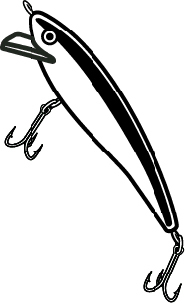
Lures and Terminal Tackle – Modern hooks are much sharper than they used to be, but always check your new lure or bait hooks and sharpen if needed. This small maintenance chore can significantly improve your hookup ratio. Wet lures can usually go straight back into their assigned tackle box compartments when you’re done using them, especially if the tackle trays are ribbed in order to help water drain away. However, if water has pooled in the bottom of any compartments, you should dab them dry with a paper towel at the end of the day and leave the tackle box open overnight. Replace any lure hooks that do get rusty. In the case of loose hooks, spread them out on a paper towel to dry if they get wet, as they will rust very easily (ditto the note about pets and children above). Be cautious not to place plastic worms or grubs in direct contact with hard lures, or the chemicals used in these soft baits will damage a hard lure’s finish. Similarly, don’t store soft plastic lures of different colors together, as the colors can bleed onto other plastic baits.
|
 |
|
The Fish & Wildlife Foundation of Florida is a nonprofit organization that seeks to protect our outstanding animals and plants and the lands and waters they need to survive. They work closely with the FWC and many other public and private partners. Since their founding in 1994, they have raised and donated more than $50 million for conservation and outdoor recreation. To learn more about how the Foundation helps us with freshwater fishing resources, subscribe to The Fish & Wildlife Foundation Newsletter. |
An understanding of fish requires not only a knowledge of the biology of the fish itself, but also study of the world it lives in and how that world affects it. While marine biology has a long history, the specific study of freshwater bodies is a rather new science only about 100 years old, and is called limnology.
Water itself is the most basic and obvious component of freshwater habitats. However, the “big picture” proves fresh water to be a surprisingly rare and precious commodity. Of all the water available on planet Earth, approximately 98% is salt water. Of the remaining 2% that is fresh water, it is estimated that the vast majority is tied up in groundwater and the polar ice caps. In the end, only about 0.01% of all the world’s water exists in livable freshwater habitats such as lakes and rivers! Unlike marine waters such as oceans and seas, this limited supply of fresh water occurs in separated and isolated habitats: individual and distinct lakes, ponds, rivers, and streams. Being small and isolated, fresh waters are also more vulnerable to change and alteration. So freshwater organisms must have many adaptations for survival that set them apart from their saltwater counterparts.
The rest of this discussion will center on lakes. Of course, there are all kinds of lakes, formed by a variety of forces ranging from glaciers to meteorite impacts to man-made constructions. No single criteria exists for classifying them all. However, one useful measuring tool for categorizing lake types involves the stages an individual lake may pass through in its “lifetime”.
A young oligotrophic lake (below) will have few nutrients present, will have a low level of biological productivity, and therefore contain a relatively sparse population of plants and animals, including fish.
Oligotrophic lake
A middle-aged mesotrophic lake will contain moderate levels of plant and animal life. Some sedimentation on the lake bottom will begin to occur as time passes.
Mesotrophic lake
An older eutrophic lake will have very high productivity of plant and animal life. For an angler, this can mean lots of plant cover that provides a robust forage base, and plenty of fish.
An older eutrophic lake
As biological productivity increases to its highest levels (hypereutrophic), sediment accumulates on the lake bottom at a faster and faster rate. The lake becomes shallower, its shorelines encroach on the open water, and eventually the lake becomes entirely filled in and turns into a terrestrial system. This process can take hundreds or thousands of years — think in terms of geological time scale rather than a human lifetime!
A very old hypereutrophic lake. This process can take thousands of years.
And that is the life of a lake! As humans with much shorter lifespans, we usually can only see "snapshots" of these different stages in various lakes around the world. Many other aspects of lakes — their water chemistry, temperature variations, depth, and plant composition — affect what fish species will occur and how abundant they might be. These are each just one more facet of understanding fish.
Size: 5-10 acres
Location: Hillsborough County
Description: Al Lopez Park is in Tampa, Florida just north of Raymond James Stadium and provides freshwater angling opportunities for all. The park was named after Baseball Hall of Fame member Al Lopez, the first Tampa native to play and manage in Major League Baseball. The park has two lakes available for fishing, a small 5-acre lake on the south end of the park and a 10-acre lake with a fishing trail near the park’s main entrance. The park is a fantastic family orientated location with a relaxing picnic vibe and large pavilions to host special events. As the heat of summer settles in, numerous large oak trees create a canopy of protection from the sun and a cool place to relax. The park also features a 1.2-mile trail, plenty of restrooms and picnic shelters, fitness centers, dog park, outdoor grills and a community center.
The lakes at Al Lopez Park are designated as Fish Management Areas that FWC manage in partnership with the City of Tampa to provide great fishing experiences. This community fishing partnership manages healthy fish populations for a diverse group of anglers to promote community involvement and access to great freshwater fishing resources.
The fishing path that circles the northern lake has two fishing piers with benches and picnic tables that create comfortable, easy access sites to enjoy time outdoors. The path is picture perfect to walk under awnings of large foliage, artistic bridges and raised walking paths. With many little paths cleared down to the lake, these unique bank fishing areas make a good place to drop a line in and catch a couple fish before moving on to the next spot.
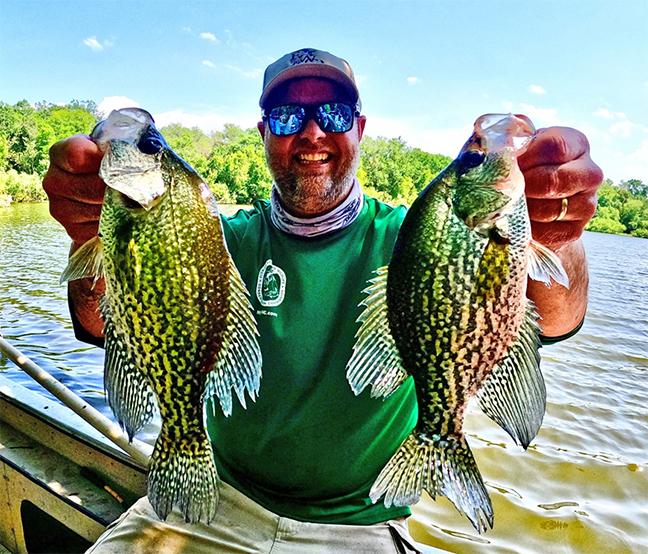
There are several fish feeders at the lake, with one positioned in front of each fishing pier. They disperse a pellet food three times a day, beginning at 9:00AM, 12:00PM and 6:00PM. Fishing at the feeders during these times can be a great experience for anyone but especially exhilarating for children. The largest fishing pier is dedicated “to all Tampa Bay anglers for their use and enjoyment.” It was built in partnership with the City of Tampa, FWC and a generous donation from the Tampa Bay Chapter of the Safari Club International.
FWC regularly stocks sportfish and forage in both lakes to enhance the health of the fish population and help create a first-rate community fishery. Since 2008, Al Lopez lakes have been stocked with over 25,000 fish! Largemouth bass, channel catfish, bluegill and redear sunfish are the primary species stocked in the lakes. Other fish species that anglers may catch in the lakes include Florida gar, bowfin, brown bullhead catfish, blue tilapia and sailfin catfish.
Channel catfish can be caught on chicken livers, night crawlers, stink bait and live bluegill fished on the bottom. Live bait is best presented for catfish on a slip sinker bottom rig while non-live bait is best presented on a 3-way swivel rig to suspend the bait just off the bottom.
Panfish species such as Redear and Bluegill can be taken on small minnows or red worms while concentrating effort around lily pads and brush in shallow water.
Largemouth bass anglers can have good luck dragging Texas rigged stick worms, fished weightless or with lightweight 1/16-ounce weights, in shallow shady areas. Small spinnerbaits also work well year-round for bass when fished in shallow or vegetated areas of the lakes using variable retrieves and pauses to find the right strike initiator.
Canoe and kayaking anglers can enjoy even more opportunities to catch fantastic fish in Al Lopez Park lakes. Although there is not a proper launch spot, there are ample areas to hand launch a canoe, kayak or even a small boat. Additionally, Al Lopez Park also hosts aquatic educational events and free kids fishing derbies for the public to come out and enjoy.
|

To contact the Florida Freshwater Angler, email John Cimbaro.
|